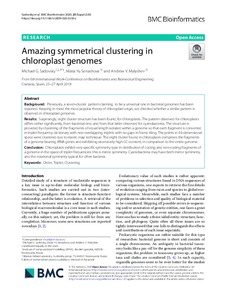Показать сокращенную информацию
Amazing symmetrical clustering in chloroplast genomes
| Автор | Садовский, Михаил Георгиевич | |
| Автор | Сенашова, Мария Юрьевна | |
| Автор | Малышев, Андрей Валерьевич | |
| Дата внесения | 2021-08-13T09:31:34Z | |
| Дата, когда ресурс стал доступен | 2021-08-13T09:31:34Z | |
| Дата публикации | 2020-03 | |
| Библиографическое описание | Садовский, Михаил Георгиевич. Amazing symmetrical clustering in chloroplast genomes [Текст] / Михаил Георгиевич Садовский, Мария Юрьевна Сенашова, Андрей Валерьевич Малышев // BMC Bioinformatics. — 2020. — Т. 21. — С. 83 | |
| ISSN | 14712105 | |
| URI (для ссылок/цитирований) | https://bmcbioinformatics.biomedcentral.com/articles/10.1186/s12859-020-3350-z | |
| URI (для ссылок/цитирований) | https://elib.sfu-kras.ru/handle/2311/142576 | |
| Аннотация | Background. Previously, a seven-cluster pattern claiming to be a universal one in bacterial genomes has been reported. Keeping in mind the most popular theory of chloroplast origin, we checked whether a similar pattern is observed in chloroplast genomes. Results. Surprisingly, eight cluster structure has been found, for chloroplasts. The pattern observed for chloroplasts differs rather significantly, from bacterial one, and from that latter observed for cyanobacteria. The structure is provided by clustering of the fragments of equal length isolated within a genome so that each fragment is converted in triplet frequency dictionary with non-overlapping triplets with no gaps in frame tiling. The points in 63-dimensional space were clustered due to elastic map technique. The eight cluster found in chloroplasts comprises the fragments of a genome bearing tRNA genes and exhibiting excessively high GC-content, in comparison to the entire genome. Conclusion. Chloroplasts exhibit very specific symmetry type in distribution of coding and non-coding fragments of a genome in the space of triplet frequencies: this is mirror symmetry. Cyanobacteria may have both mirror symmetry, and the rotational symmetry typical for other bacteria. | |
| Название | Amazing symmetrical clustering in chloroplast genomes | |
| Тип | Journal Article | |
| Тип | Journal Article Postprint | |
| Страницы | 83 | |
| Дата обновления | 2021-08-13T09:31:33Z | |
| DOI | 10.1186/s12859-020-3350-z | |
| Институт | Институт фундаментальной биологии и биотехнологии | |
| Подразделение | Bio7 | |
| Журнал | BMC Bioinformatics | |
| Квартиль журнала в Scopus | Q1 | |
| Квартиль журнала в Web of Science | Q1 |

